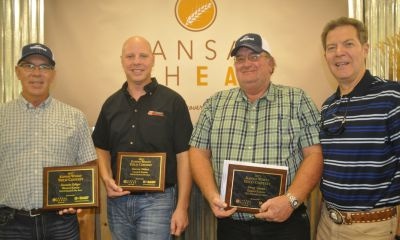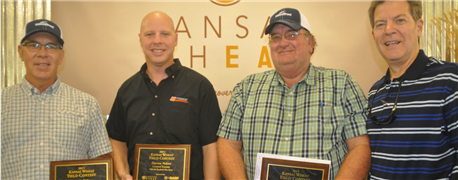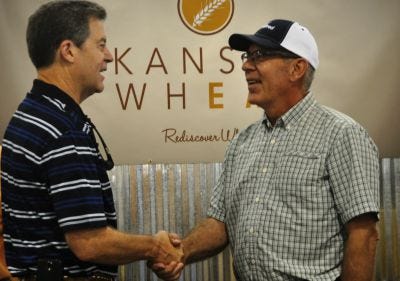
The strange, challenging and ultimately rewarding wheat year of 2015 brought any number of interesting developments, not the least of which were two of three Kansas Wheat Yield Contest winners harvesting more than 100 bushels per acre and other, who lived through extreme challenges topping 70 bushels.
It was, they all agreed, a demonstration that management counts even in the best of conditions and counts big time when conditions get demanding.

WHEAT WINNERS: Gov. Sam Brownback, right, presented plaques to winners in the annual Kansas Wheat Yeild Contest at the State Fair on Sept. 17. Western Region winner Darwin Ediger, left, harvested 103.18 bushels and was also the Wheat Quallity Champion. Darren Nelson, center, was the Central Region winner and top yield winner with 108 bushels per acre and Doug Queen, was Easterm Region winner, topping 70 bushels even though challenged by an extremely wet harvest season.
The top yield winner was the Central Region contestant, Darren Nelson, who farms in Reno County and harvested a whopping 108.48 bushels to the acre on an 8.756 acre lot planted with a blend of T158 from Limagrain and Everest, a Kansas Wheat Alliance variety.
"The surprising thing is I did nothing on that plot that I didn't do on the rest of the field," Nelson said following a ceremonial plaque presentation at the Kansas State Fair on Sept. 17. "The average of the whole field topped 90 bushels to the acre."
For that, Nelson credits "near perfect" fill conditions following very timely rains from mid-April to late May. Prior to that period, his field, like most fields of Kansas wheat, faced wildly fluctuating temperatures during an extremely dry winter and early spring.
"We got a grain fill period that rivals Europe," he said. "We had six weeks of wet weather and cool temperatures. I had already made the decision to apply fungicide in early April. It thought 'well, it's not dead, anything can happen,' and just went for it."
That decision paid off big time. When the rains stopped and the temperatures rose in June, Nelson said he got ideal ripening conditions and not a drop of rain until the end of harvest.

QUALITY WIN: Gov. Sam Brownback, left, shakes hands with Darwin Ediger, this year's winner of both the Western Kansas yiield contest and the statewide wheat quality contest. Ediger farms near Meade in southwest Kansas.
Fungicide application was also at the top of 'reasons for success' list of Darwin Ediger of Meade who won the Western Region yield contest. Ediger harvested 103.18 bushels per acre on his dryland 6.48 acre plot that was plantaed with WB4458 from WestBred.
Ediger was also the winner of the Quality Award and a $250 check based on grading by the Kansas Grain Inspection Service and analysis from the ADM Milling Laboratory in Kansas City.
"Darwin's winning wheat yielded more than 100 bushels per acre and still won the quality contest. That is pretty amazing," Justin Gilpin, Kansas Wheat CEO, said. "The sample's mix time of more than 11 minutes with overall dough strength 'raised' this sample to the top this year."
The growing finishing in third place this year was Doug Queen of Rossville, Eastern Region winner.
Queen's winning plot was 11.94 acres planted with Armour, a WestBred variety, and resulted in a yield of 70.3 bushels per acre.
His crop was challenged not only by the wild weather of the winter and early spring but by unrelenting rain that soaked fields prior to and during harvest season.
"We're figuring out how to manage fields that are pretty torn up from being harvested in mud," he said. "It was a real mess."
Mess or no, Queen had pretty impressive yields in the area of the state most challenged during grain fill and harvest in a year when "average" came in at 38 bushels to the acre all across the state.
The difference, he said, in agreement with other yield winners, was management.
"I made the decision to apply fungicide," he said. "In fact, I made two applications. I think it made a huge difference."
Ediger, the quality winner, said the WB 4458 variety impressed him throughout the year, but especially during grain fill.
"WB 4458 stands well - it is a very beautiful wheat," he said. "When conditions are right, it is going to keep putting the berries on."
Ediger credited wheat breeders with developing more improved varieties each year.
"The wheat industry has changed so much in the last five or six years. It is exciting," he said. He remarked that wheat breeders are providing such great varieties that it has become harder to make selections each year - a good problem to have.
Even the best varieties, however, cannot succeed without good management. Ediger and his son Tyler have implemented best management practices into their dryland wheat and grain sorghum operation. That includes utilizing no-till to improve soil fertility and increase organic matter, testing for nitrogen and sulfur levels each year and applying yield maps when writing prescription maps for every field.
Ediger said he and his son also emphasize the importance of seed treatments to establish good root development and plant healthy from the start as well as applying fungicide early, before disease pressure starts to show. They even use a drone to spot trouble spots in the middle of fields that would not otherwise be visible.
"Each field is treated differently than the next," he said, "Good management practices are just as important for cost savings as yield increases."
Ediger's management practices are important for more than high yields. He explained that all of their wheat is used for certified seed, so aiming for top quality is imperative every year.
"Quality was bred into me since I was young," Ediger said. "You never attain 100 percent quality, but you shoot for it."
About the Author(s)
You May Also Like






